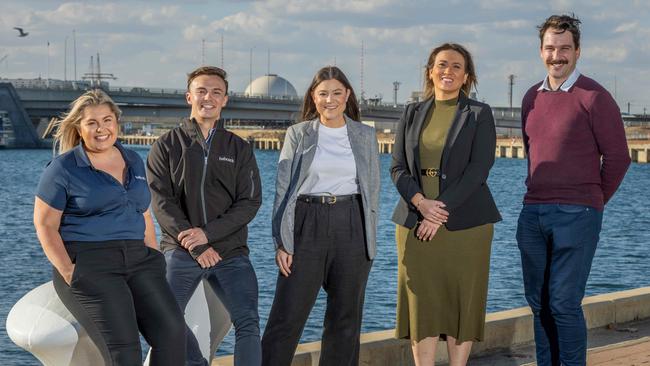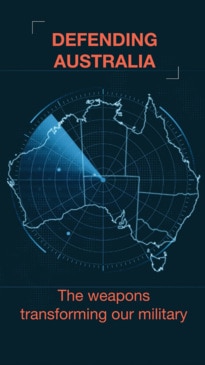SA’s defence opportunities range from ocean depths to outer space
SA’s role as the defence industry state extends far beyond naval projects – we’re also making waves in groundbreaking hi-tech projects spanning space, AI and electronic warfare.

SA News
Don't miss out on the headlines from SA News. Followed categories will be added to My News.
South Australia is positioning as a major defence industry state beyond the mammoth nuclear-powered submarine enterprise, aiming to become a key player in aerospace, AI, electronic warfare and missile testing.
Highlighting the presence of seven of the world’s top 10 defence firms, state Defence and Space Industries Minister Stephen Mullighan said SA had a long-held strategy of pitching for projects in the national interest.
This stemmed from construction of the Collins Class submarine fleet at Adelaide’s Osborne Naval Shipyard from 1989 to its consolidation as the nation’s premier naval shipbuilding facility after sealing an air warfare destroyer construction contract in 2005.
But Mr Mullighan emphasised SA’s defence sector extended greatly beyond naval shipbuilding, pointing to the RAAF Edinburgh “superbase” complex in Adelaide’s north, including the Defence, Science and Technology Group (DSTG).

He also highlighted the RAAF’s Woomera Range Complex, in the state’s Outback, where missiles, ground-based weapons systems and other explosive ordnance are tested.
“We are very much focused on finding specific opportunities in the defence and space industries, where we think that we’ve got a competitive advantage and trying to execute against those opportunities,” he said.
“So rather than trying to be everything to all parts of the defence forces, we know that our past history has shown us that when we when we focus our efforts on particular opportunities that we can secure, enormous benefits out of that – that’s been the history of naval shipbuilding.
“What I’m interested in is making sure our state absolutely succeeds in the delivery against those naval shipbuilding programs, but at the same time, we look for those particular opportunities more broadly across defence.”
SA had gained an early mover advantage in the critical field of artificial intelligence, he said, through the 2018 formation at the University of Adelaide of the Australian Institute for Machine Learning.
“I think it’s really impressive that the University of Adelaide chose to specialise in this field and make that investment several years ago now, because it’s now positioned them (but in turn our state) really well for being able to contribute in the defence and space industries in a much deeper way than what we would have otherwise,” he said.
Mr Mullighan said the enormous amount of work to be conducted in SA would create opportunities for other states in a race for Australia to gain defence capability and “get the maximum output in the shortest period of time”.
“The thing that’s exciting from a national perspective is the hundreds of billions of dollars that need to be deployed between now and 2050 means that there will be a step change for our country’s industrial capacity when it comes to delivering for defence,” he said.
“I think what we’re seeing now is states are starting to coalesce around where their experience and where their expertise and capabilities are.
“For us, it’s certainly around shipbuilding, but we’ve also got more broader, perhaps more niche opportunities when it comes to aerospace, cybersecurity, AI, electronic and advanced capabilities.”

Major defence projects in SA include:
AUKUS nuclear-powered submarine construction centred on Osborne in a $368bn project.
CONSTRUCTION of six Hunter Class frigates, also at Osborne, in a $45bn project.
A $160m RAAF EDINBURGH upgrade for heavy maintenance and modification of the P-8A Poseidon maritime surveillance aircraft.
MISSILE and ground-based air defence systems at Norwegian firm Kongsberg’s first stand-alone Asia Pacific facility, a $25m Adelaide headquarters opening in June, housing up to 150 staff.
TESTING and integrating tracking command antennas for future flight trials of hypersonic missiles, at Raytheon Australia’s Adelaide Centre for Joint Integration at Technology Park Adelaide.
NATION-LEADING cyber capability at Lot Fourteen, Adelaide, with the Australian Cyber Collaboration Centre.
ELECTRONIC warfare capability including the Jindalee Operational Radar Network (JORN), Australia’s first comprehensive land and air early warning system.

Mr Mullighan, also the SA Treasurer, said the state government had a longstanding and deliberate strategy of seeking defence projects as a larger share of economic output, dating back to a push from early 2002.
This was designed to leverage the Collins Class submarine construction, under which ASC, previously the Australian Submarine Corporation, built six submarines at Osborne under a $5bn contract signed in 1987.
Three Hobart-class air warfare destroyers also were built by ASC at Osborne, in a project secured in 2005 that consolidated the western Adelaide facility as the nation’s premier naval shipyard.
More Coverage
Originally published as SA’s defence opportunities range from ocean depths to outer space





